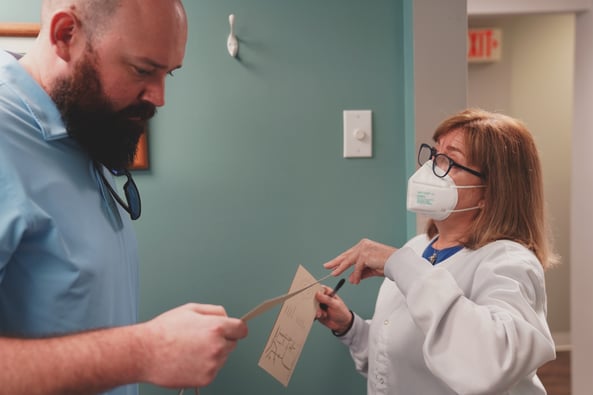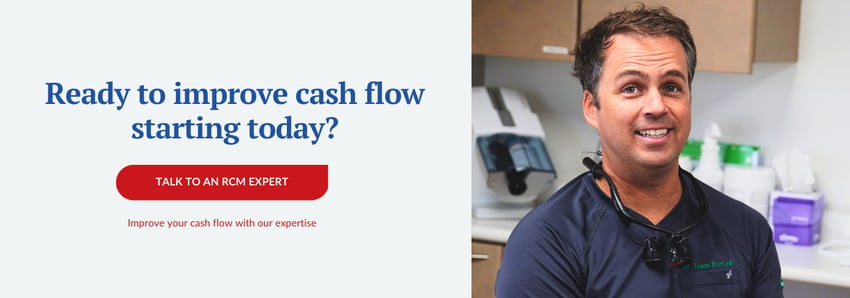6 common dental billing errors that cost your practice


As we all know, the dental billing process is complicated. If your process includes outdated dental insurance billing practices or preparing claims without proper training, you risk using illegal dental billing practices without even knowing it. Insurance companies thrive on the incidence of dental billing errors.
The more small details you have to remember, the more likely mistakes will occur, enabling insurers to deny your claims. That’s why it’s important to spot common dental mistakes early, fix them, and prevent them from happening.
And when it comes to your dental billing, repeating mistakes that you can avoid is costly.
Dental ClaimSupport is a dental billing company that proactively helps dental practices send clean insurance claims and collect higher payments. On your behalf, your biller will submit more accurate claims, collect on your outstanding insurance aging reports and diligently send appeals for any denied claims so you are reimbursed promptly.
We’ve seen the most common mistakes dental teams make when moving through the dental billing process through the years of working with them. Let’s help you to avoid them.
In this article, you will learn the most common dental billing errors, why they happen, and why it’s costly to let these mistakes continue. Understanding the common mistakes other dental teams make can help yours avoid them - and reprioritize their dental billing process in order to collect more.
1. Missing or inaccurate patient information
Inaccurate information on an insurance claim is one of the most common errors in dental billing. It’s costly because it will almost certainly increase your chances of claim denials and overhead costs due to rework. And if your claim is denied, your payment from insurance companies will be delayed, and your workload will multiply to research, fix, and appeal the claim to get it paid
The money your practice brings in from insurance is crucial and can account for about 50% of overall revenue. So cost-effective insurance billing is a huge benefit to your practice.
Data entry mistakes are the number one dental billing error to avoid because you have the power to reduce them. Clean data is vital to smooth insurance billing in a financially healthy practice.
Be sure to collect information from patients upfront
There is information you should confirm with patients every time they visit, even if they are a reoccurring patient. Especially because plenty of this information could change.
Ask about any updates to personal information especially:
- Home address
- Phone number
- Employment status (did they change jobs or retire since the last visit?)
Also, always double-check the following insurance information:
- Name of insurance provider
- Member ID number
- Member DOB
- Patient DOB, if different than the Member
- Name of employer
- Group ID number
- Telephone number of insurance (if you do not have a login for the web portal)
Obtaining this information is also the first step of the insurance verification process. We’ll get into this next.
2. Inattention to the insurance verification process
Insurance verification is the process of updating the details about a patient’s coverage and eligibility before treatment.
Using inaccurate insurance information is another common dental billing error. Finding a good system for insurance verification can be a challenge for dental teams. It’s the least favorite part of the process for many people because it can feel a little mindless and repetitive.
But it’s crucial to get this first step in the billing process right. It lays the foundation for how the rest of the life cycle of the claim will go. Aka - it will determine if a claim is or is not going to be reimbursed. Not to mention, properly verifying insurance benefits keeps your patients happy with clear communication about their own benefits.
When this process isn’t in a good place - you might get patient information incorrect when creating their claims, as we mentioned above. So much as an insurance ID number out of place can lead to claim denials. So prioritize this process - make sure you’re confirming their information over the phone, then again when they check-in at your office.
Here are a few tips to help you streamline insurance verification:
- Start early - get the patient information several days before their scheduled visit
- Get a full breakdown of benefits when necessary
- Use the same information for each family member
- Verify the patient’s insurance maximum and deductible amounts and the
remaining amounts for the benefit year or calendar year
Speaking of insurance verification and patient costs - this means you also need to be correctly calculating patient out-of-pocket costs.
Accurately calculate patient out-of-pocket costs
As you perform insurance verification, not only are you checking to make sure the patient has active insurance coverage, but you can see which procedures are covered and just how much each procedure is covered. And you can use this to estimate the out-of-pocket costs for your patient.
Doing this calculation properly is important because if you’re way off, your patient is not going to be happy with you. Dental teams struggle to estimate the patient’s payment because there are always going to be deductibles, downgrades, waiting periods, exclusions, and other factors affecting the percentage that insurance will cover. It can get complicated.
It might be tempting to read this and think, “oh, I could just get a predetermination to calculate this for me!”
And to that we say: why wait and wait and wait for insurance companies to give you that information when you calculate it yourself in a few minutes?
Pre-determinations are also not approved the first time around and could request more info. Not only do pre-determinations delay treatment, but by the time it's approved, the treatment for the patient may have changed.
We find that calculating out-of-pocket costs manually or through your insurance verification software is more efficient because you don’t have to wait as long for a result - you can find out the result immediately! When you do this yourself, you can share your insurance verification and billing information faster and with more confidence.
Learn how to correctly calculate patient out-of-pocket costs in our Learning Center.

3. Coding errors
Another common reason for low collections are coding errors. And listen… we feel you on this one. Coding is one of the most difficult parts of dental billing. CDT procedure codes change every year, and keeping up with the details can be extremely confusing.
But it’s crucial that your team gets this right and is properly trained on coding. Coding mistakes not only lead to claim denials, but you could also unintentionally commit fraud by not coding correctly. And this, of course, could cost your practice far more than some unpaid claims.
Stay up to date with CDT codes
The best way to avoid coding errors is to continuously stay up to date with them. Your team should be continuously trained on all things CDT and ICD-10-CM. You might be thinking, how do I do that?
There are plenty of resources online including Dental Claims Academy. Invest in your team’s dental billing knowledge so that you can collect as much as possible from insurance and create a more optimized dental practice.
4. Failing to avoid lower repayment due to bundling
Unfortunately, insurance companies love to find ways to pay you less. Bundling is one of those “fine print” details that insurance payers throw into contracts with dentists. And misunderstanding how insurance adjusters bundle procedures can make it hard to collect payment for the work your dental team has done.
Bundling is the practice of combining multiple procedures into one procedure which is covered at a discounted rate. This reduces the revenue the dentist can collect, and benefits the insurance company.
Understand how procedure bundling works
Here is an example to help you further understand how to accurately handle bundling.
Let’s say you performed a panoramic x-ray as well as bitewing x-rays. Two different procedures, right? Well, insurance will sometimes bundle those together and call it an FMX full mouth series, and reimburse you a lower amount for the full mouth series.
So if you do a panoramic x-ray that costs $100, and you do a bitewing x-ray that costs $50, you should get paid $150. However, the code for an FMX fee is $125. So insurance can say, “we're bundling the panoramic x-ray with the bitewings x-ray. Together, it will pay you on the FMX, you only get paid $125.”
If you charge $150 for this but are only paid $125, typically that’s $25 you’ll have to write off if you're in-network with the insurance company.
Knowing this “fine print” rule is especially important when submitting claims. If you’re going to send the procedures “unbundled” to get your full PPO fee and avoid a denial you need to explain via CDT coding why these are separate procedures. Some of the new 2022 CDT codes are actually unbundled. Check out the new, edited, revised, and deleted code in the 2022 CDT codes.
5. Filing claims inefficiently
Not only do you want your claims filed with the correct information to avoid denials - you need to file them in a timely manner. This means there needs to be a system in place for how you file claims and how you work your outstanding insurance aging report. Spoiler alert: both need to be done OFTEN.
Timely filing limits come at you faster than you think. Each insurance company has its own set of rules when it comes to the amount of time you are given to get a dental claim to an insurance company. Some, like Medicaid, only allow 90 days while others might give you an entire year.
That’s why you should submit claims as soon as you can, and work your outstanding insurance aging report once a week minimum. The longer it takes to get a claim paid, the less likely it is to ever be paid.
Submit claims within 24-28 hours after the procedure
We recommend your office send claims within 24 hours of the date of service.
The day your patient has a treatment after the procedure is complete, you should be creating and batching that claim. If a procedure is performed on a Monday, and you wait to create the claim until Thursday, there is a higher chance of procedures being incorrectly reported, or not reported at all.
This can have a negative impact on work efficiency for your front office if corrected claims have to be submitted later, or cause you to miss out on revenue. Also, your claim payment will be delayed, and time is money!
You should also have these claims “approved” the same day, ready to be sent to the claims batch processor.
By approved, this means have your providers make sure the procedures being sent on a claim form for each patient were actually performed that day.
Some offices like to send claims the next business day, allowing their providers time to audit each patient and be 100% sure all of the procedures performed for the patient are accurate.
Whoever is in your office, at least one person should be responsible for going through the schedule and making sure every single patient on their schedule that day has had a claim created and batched. This will guarantee that no later than the next business day, the claim is set to be on its way to insurance.
Work the insurance aging report at least once a week
Once a claim is off to be paid by insurance - you need to start focusing on older, “aged” claims that have been denied and are sitting on your aging report. The longer these aged claims spend on the aging report, the less likely they are to be paid.
To “work” the outstanding insurance claims on the aging report, go line by line, claim by claim, by the insurance company. Look at each unpaid claim and while you contact the insurance company via the web portal, we recommend picking up the phone and speaking to a real person.
You should have someone in your office working on your aging report at least once a week, minimum. Make sure every claim is touched and notes are made on ALL outstanding claims.
It’s important to have a system in place where someone is in charge of this specifically so that they are aware of any claims that may have fallen through the cracks ASAP. The more you are checking on these unpaid claims, the quicker they get resolved and your practice gets its money.
6. Forgetting attachments to claims
If you’ve done your insurance verification, and you’ve double-checked your data entry, but you’re still seeing claim denials - chances are that you forgot an attachment or supporting documentation.
Supporting documentation is the evidence attached to an insurance claim, which tells the insurance company why the dental procedure was necessary. It’s proof that services were needed.
It’s a common error for dental teams to not attach x-rays, intraoral photos, and sufficient clinical notes. We always advise the in-house team to “over-explain” themselves when it comes to attachments and narratives, because the more information you provide to insurance companies, the less likely they are to deny reimbursement.
Not only could you miss out on claim reimbursement when forgetting these attachments, but you could get into legal trouble without them.
For example, let’s say you treat the patient, but you don't have documentation to support what you did, and then the insurance denies the claim. Then the patient is notified by their insurance that the claim was denied because they “didn’t need the procedure.”
Now the patient, who doesn’t know how insurance denials work, might be alarmed that they paid for unnecessary dental work. We’ve seen this scenario play out, and it can lead to an ugly situation. If you always have sufficient documentation, you should have no reason to worry.
It’s direct proof that can help prevent disputes from escalating, or protect you if they do.
Always include x-rays, intraoral photos, and clinical notes
Different procedures require different forms of documentation. These procedures and their specific documentation are a lot to keep up with, and it is common for dental teams to forget to add all of the details.
You might be thinking, “why would someone forget this?” but it’s easy to not realize when an x-ray isn’t enough proof for a needed procedure. An x-ray doesn’t really see what the naked eye can, so maybe a photo is needed. It’s difficult to keep up with what’s necessary for reimbursement.
Learn more about the importance of attachments and what procedures require which types of attachments in our Learning Center.
Ready to cultivate an amazing dental billing process?
As you can see - there are a lot of ways your dental billing can go awry. And mistakes happen all the time. The best thing your team can do to avoid these mistakes is to learn about them, and continuously educate themselves on dental billing best practices and coding.
The first step to avoiding these mistakes overall, and creating an efficient and streamlined dental billing process.
Dental ClaimSupport is a great tool for helping dental practices optimize their billing process to collect more from insurance and patients, while also remaining compliant. With the help from Dental ClaimSupport, your team will be able to focus on patient service and keeping the schedule full.
To learn more about what makes for a great dental billing process, visit our Learning Center.
Related Posts
Dental revenue resources from Dental Claim Support



